Freshmen have been excluded from these previews, as we'd like to wait and see what they have to offer on the NCAA level before we come to any long-term conclusions.
-Top 20 Prospects in the Big Ten
-Top 25 Prospects in the ACC
-Top 15 Prospects in the Big 12
-Top 15 Prospects in the Pac-12
-Top Prospects in the Big East #1-5
-Top Prospects in the Big East #6-10
#11 Vander Blue, 6-4, Sophomore, Shooting Guard, Marquette
Coming off an underwhelming freshman campaign, we've elected to wait and see what type of progress Vander Blue made with a fresh perspective in a few months, rather than jumping to conclusions too quickly based off his 2010-2011 game footage
#12 Gus Gilchrist, 6'10, Senior, Power Forward, South Florida
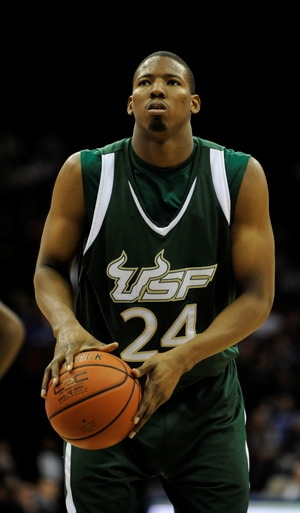
Jeff Rush
Gus Gilchrist came into the 2010-11 season as the clear offensive leader for South Florida after the departure of Dominique Jones. He held up his end of the bargain, leading the Bulls in scoring and finishing 2nd in rebounding, but struggled to lead his team to victories, as they won 10 fewer games than they did the year before. On top of that, he did not show significant progress in his skill level. Heading into his senior year, Gilchrist will have one more opportunity to take his game to the next level in Tampa.
Gilchrist possesses solid size and an intriguing frame for the next level, but is not a high level athlete by any measure. He plays the game almost exclusively below the rim and this often hurts his ability to finish in the paint -a legitimate concern as he progresses to the professional ranks.
As we pointed out last year, Gilchrist's game revolves around his jump shot. He hunts for jumpers, often leaving good position in the post or popping after setting a ball screen when a roll to the basket would have been the better play. He has not expanded his game the way that scouts had hoped and saw a significant drop in his shooting percentages when he became the primary offensive option in his junior year. Most of the 7% drop in his true shooting percentage can be attributed to his struggles from the three point line where he took a step back from the interesting efficiency he showed as a sophomore in a limited sample.
Gilchrist spends most of his time at the 4, which would be his position at the next level, and at 6'10 he is one of the bigger power forwards in the Big East. Though this gives him a decided advantage over smaller power forwards in post-up situations, he tends to settle for shots away from the rim rather than using his physical tools down low. He does have the ability to make jumpers after facing up in the post, and will take advantage of slower opponents by putting the ball on the floor with simple drives to the rim, but lacks a degree of physical assertiveness on the block.
While Gilchrist's numbers may not have progressed significantly since his freshman year, he remains a capable offensive threat for a player his size, especially when you consider the number of looks he has to create for himself. According to Synergy Sports Technology, only 15% of the power forward's touches come off of basket cuts, an indictment of the ability of his guards to create easy looks for him.
Outside of his scoring arsenal, Gilchrist hasn't shown significant development in any one area, remaining essentially the same player he was as a freshman on a number of levels. His per-40 pace adjusted statistics are fairly stagnant across the board, and though his efficiency as a scorer has varied, the rest of his game has not, both qualitatively and on paper. He remains the same average rebounder who is not an impact defender or an eager passer.
Gilchrist is not a particularly intimidating defender at this point. As we've noted in the past, Gilchrist is not very quick laterally which makes him a liability on the perimeter. He also lacks the toughness and the explosiveness to cause problems as a defender in the post. It is clear by watching Gilchrist that his focus and effort are concentrated mostly on the offensive end of the floor, and an improvement on the glass and as a defender around the rim would be a significant plus for the rising senior.
Although he can be very effective on the offensive end of the court by using his size, length and ability to shoot the ball, Gilchrist has some things to work on to improve his draft stock. His game has not shown the type of improvement that you would want to see after his breakout freshman year. That being said, any player with the size, length, and ability to shoot the ball that Gilchrist possesses is certainly intriguing, and regardless of his progress this season, he is an ideal candidate for the Portsmouth Invitational Tournament.
#13 Fab Melo, 7'0, Sophomore, Center, Syracuse
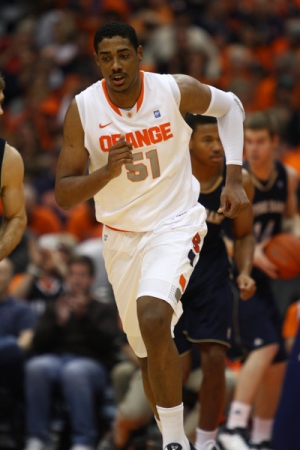
Fab Melo's freshman year at Syracuse quickly became a telling revelation of where he stood in his learning curve. Considering his high ranking as a recruit, some were quick to call his season a disappointment, but for the purposes of his NBA potential, his struggles were a prime example of the old adage regarding how big men take longer to develop than any other group of prospects. Despite the lofty expectations some had for the young 7-footer, it became clear that patience would be a virtue when evaluating the former McDonald's All-American.
Like so many young centers we've seen over the years, Melo spent the better part of the season on the bench. When he did see the floor, he appeared to struggle with the fundamentals of the game on both ends while showing little feel for the game. Furthermore, he had trouble using his physical tools to his advantage, largely looking as though he was just getting acclimated with his surroundings. Melo did string together a few solid performances as the Big East Tournament began, but even those glimpses into his skill-set were brief. Though he may not have had a terribly productive season, Melo did seem to develop some habits that may help him in the future.
Entering last season out of shape, Melo's weight has been a concern on a number of different occasions since he emerged on our radar. A legit 7-footer, when Melo is in poor shape, his athleticism suffers, but when he trims down, he looks noticeably quicker, even if he isn't a dynamic athlete by any stretch. The Brazilian big man still needs to continue working on his strength in the weight room, but he appears to be starting this season in a much better place than he did last year in terms of conditioning, which is a promising sign.
As far as his skill level is concerned, there is little we can add to what we've previously written about him at this point. Melo lacks much in the way of basic post skills and footwork, but still knocks down an occasional midrange shot, rolls in a right handed hook, or finishes the a lobs his teammates throw him when defenders play off him. Looking at Melo's small body of work in the post, he made a couple of nice step through moves last season, but would be well served to improve his jump hook, considering how valuable a tool that can be for a player his size at this level.
Melo doesn't have a natural feel for making plays offensively, was never more than the fifth option when he was on the court, and had the ball simply stripped out of his hands quite regularly, but seemed to put things together on a few occasions as a post passer doing a fine job dishing the ball in traffic, usually to Rick Jackson.
On the defensive end, Melo made his long-awaited debut as the anchor of Syracuse's zone, but struggled to make his presence felt for significant stretches. Still learning the nuances of the 2-3 and finding himself regularly out of position and in foul-trouble, his impact was limited on this end of the floor. When he wasn't in foul trouble, Melo blocked shots at a terrific rate, aggressively pursued rebounds, and remained active, but will need to improve his fundamentals, understanding of the 2-3, and discipline around the basket to stay on the floor and reach his exceptional defensive potential.
With highly touted freshman Rakeem Christmas entering the fold for the Orange, this season will be an interesting one for Melo. He is already well ahead of where he was last year in terms of conditioning, but will face stiff competition for playing time. He has some off the court issues to address, including an upcoming court date for a domestic incident, but has the chance to take a big step forward on the floor. There's no questioning the young center's potential, or that he's a ways away from fulfilling it, but his ability to put things together and earn extra playing time in the short-term will be an important step in his development.
#14 C.J. Fair, 6-8, SF/PF, Sophomore, Syracuse
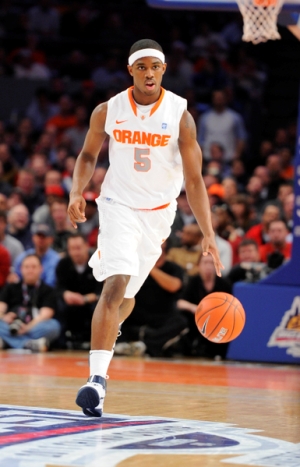
Joseph Treutlein
A top-100 recruit out of high school, C.J. Fair had a modest debut season for Syracuse last year, averaging 6.4 points in 18.6 minutes per game.
Standing 6'8 with a solid frame and very good length, Fair is a good overall athlete for a combo forward, being fast in the open floor and showing nice vertical explosiveness when he builds momentum. He's still raw with most of his skills and has a certain awkwardness to some of his movements, but likely can improve on that with time.
On the offensive end, Fair does the vast majority of his work operating off the ball, with just 19 of his 218 possessions logged by Synergy being of the isolation variety. He sees most of his possessions on cuts, offensive rebounds, and spot-up opportunities, doing very little to create his own shot and not showing much in terms of a perimeter jumper yet.
Working off the ball, Fair shows a very active motor and solid awareness of spacing, constantly moving around in Syracuse's offense and doing a nice job finishing on cuts in the lane. He shows nice creativity and touch at the rim, finishing well on the move. His athletic abilities also show up much better in transition, where he does a better job harnessing his leaping ability when relatively unimpeded to the basket and not having to worry about putting the ball on the floor.
Fair also sees a lot of opportunities on spot-up, straight line drives, something he shows varying success with depending on the situation. Fair's ball-handling skills are still underdeveloped, not showing much in terms of change of direction ability or control in tight spaces, while he also struggles getting to top speed with the ball in his hands. In well spaced situations, he's able to utilize his long strides to overcome these shortcomings and excel, but when the lanes are crowded he struggles to consistently produce. He does occasionally flash an impressive spin move and shows solid instincts when he has space to operate, but is still very raw overall.
The biggest area Fair is lacking in right now is with his perimeter shooting ability, something he shows very little of on a consistent basis. He took just 32 jumpers on the season according to Synergy, while scoring a poor 0.72 points per shot on those attempts. His FT% was a similarly disappointing 61%. Fair's form is not particularly refined or consistent and his touch is problematic the farther he gets from the rim, something he will definitely need to work on given his lack of shot creation abilities.
Defensively, as is the case with most Syracuse players, Fair is mostly untested as a one-on-one perimeter or post defender, playing almost exclusively the forward spots in Syracuse's 3-2 zone. Like most Boeheim players, Fair shows a good level of focus and activity on defense, constantly keeping his eyes on the ball and moving well off the ball to stay with his man and contest shots, but he appears very raw in the few instances he's tested on isolations. Fair has a high center of gravity and doesn't look very comfortable moving laterally, something he'll definitely need to improve on despite the lack of opportunities to do so at his school.
Looking forward, Fair is still a very raw player who shows flashes in a lot of areas, and he will probably need more time and opportunities to fully developed. While he looks like he'd be ready to expand his game some this season, that may be tough to do given Syracuse's situation, as they're returning the vast majority of their rotation and have a strong recruiting class incoming with two ESPN Top-25 recruits. Continuing to improve his ball-handling, perimeter shooting, and defense should be among Fair's priorities, but he still has plenty of time left to add some polish to his game as he's still just 20 years old with three years left on campus.
#15, Talib Zanna, 6-9, Power Forward/Center, Sophomore, Pittsburgh
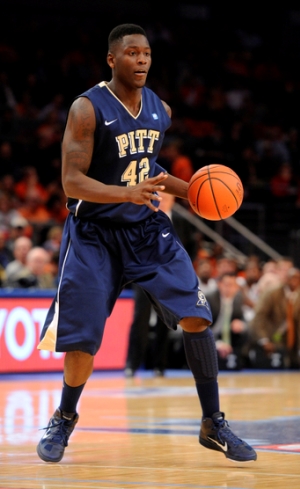
Walker Beeken
After being granted a medical hardship waiver for the 2009-2010 season with an injured shoulder, Pittsburgh's Talib Zanna shined early as a freshman, putting up season-highs of 14 points and 12 rebounds in a win over Maryland in Madison Square Garden in November. Unfortunately, the rest of Zanna's freshman season didn't go as well, as he earned inconsistent minutes in a crowded Panther frontcourt, playing sparingly through the Big East schedule, before sitting out the last seven games of the season with an injury to his right thumb.
Despite Zanna's lack of minutes and on-court production as a freshman, he still displayed enough potential to establish himself as a prospect down the road, most notably due to the physical tools that he brings to the table. The Nigerian big man has good size for the power forward position at 6'9, with a solid build and what appears to be a long wingspan. He couples that with an excellent motor and very good mobility for guy his size.
Offensively, Zanna is still a bit raw at this stage and played a very minor role last season, mainly only touching the ball on offensive rebounds and off of cuts around the basket, and hardly seeing any post touches. His athleticism and aggressive mentality help him finish at the rim, as he shot a solid 56% from the field last season, making the most of his opportunities. He also runs the floor hard on every possession, making himself available for easy baskets and put-backs.
He showed glimpses of being able to shoot mid-range jumpers, and looks to have decent touch, but he seems to lack confidence in his stroke, and still has work to do, as evidenced by the very poor 48% he shot from the free throw line as a freshman.
Defensively is where Zanna has excellent potential. He's big, strong, and long enough to defend in the post, and also possesses the mobility and lateral quickness to step out and defend some on the perimeter. Most importantly, he plays with outstanding intensity and effort and is playing for a coach in Jamie Dixon who is known for producing tough players who understand how to play on the defensive end, which should bode well for him down the road.
Zanna utilizes the same relentless energy to be a force on the boards, where he averaged 12.3 rebounds per forty minutes pace adjusted as a freshman for one of the best rebounding teams in the country.
This season could give a better indication's of Zanna's professional potential, but the extent of his playing time and role is uncertain. With the return of starter Nasir Robinson and former McDonald's All American Dante Taylor, as well as the addition of heralded freshman Khem Birch, minutes at the four and five spots could once again for hard to come by for the 21 yeard old sophomore.
Pittsburgh should once again be one of the top teams in the Big East, and Zanna's physical attributes and energy will make him an intriguing player to watch. While a breakout sophomore season may not necessarily be in the cards, NBA scouts will likely be keeping an eye on Zanna's development over the course of his time in Pittsburgh.













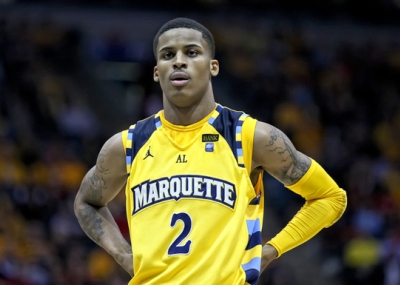























Comments